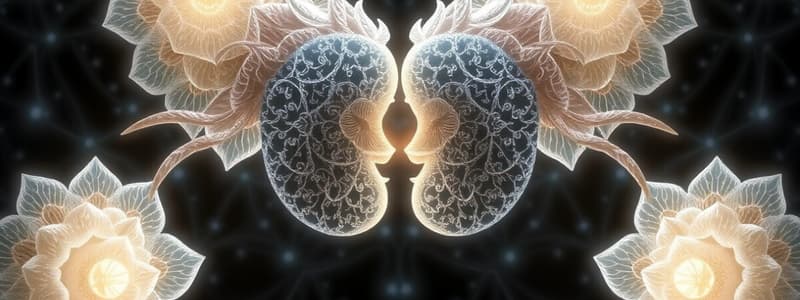Podcast
Questions and Answers
Empareja las siguientes fases de la Meiosis I con sus eventos clave:
Empareja las siguientes fases de la Meiosis I con sus eventos clave:
Profase I = Se produce el entrecruzamiento (crossing over) Metafase I = Los pares de cromosomas homólogos se alinean en la placa metafásica Anafase I = Los cromosomas homólogos se separan y se mueven a los polos opuestos Telofase I = Los cromosomas llegan a los polos y la célula se divide
Empareja las siguientes características con la división celular correspondiente:
Empareja las siguientes características con la división celular correspondiente:
Mitosis = Produce dos células hijas diploides idénticas Meiosis I = Reduce el número de cromosomas a la mitad Meiosis II = Separa las cromátidas hermanas Ambas (Mitosis y Meiosis) = La profase implica la condensación de los cromosomas
Relaciona los siguientes términos con su descripción:
Relaciona los siguientes términos con su descripción:
Haploide = Célula con la mitad del número de cromosomas (n) Diploide = Célula con el número completo de cromosomas (2n) Cromosomas homólogos = Par de cromosomas con genes similares, uno de cada progenitor Gametos = Células sexuales (espermatozoides y óvulos)
Empareja los siguientes términos con su importancia en la meiosis:
Empareja los siguientes términos con su importancia en la meiosis:
Relaciona las siguientes etapas con el resultado final de la meiosis:
Relaciona las siguientes etapas con el resultado final de la meiosis:
Asocia las siguientes fases de la meiosis con los eventos que ocurren en ellas:
Asocia las siguientes fases de la meiosis con los eventos que ocurren en ellas:
Empareja los siguientes términos con su contribución a la diversidad genética:
Empareja los siguientes términos con su contribución a la diversidad genética:
Relaciona el tipo de división celular con su propósito principal:
Relaciona el tipo de división celular con su propósito principal:
Flashcards
Meiosis
Meiosis
División celular que reduce a la mitad el número de cromosomas para formar gametos.
Meiosis I
Meiosis I
Primera división de meiosis, donde se separan los cromosomas homólogos.
Prophase I
Prophase I
Fase más larga y compleja de Meiosis I, donde ocurre la sinapsis y el cruce.
Crossing Over
Crossing Over
Signup and view all the flashcards
Meiosis II
Meiosis II
Signup and view all the flashcards
Gametos haploides
Gametos haploides
Signup and view all the flashcards
Diferencias entre mitosis y meiosis
Diferencias entre mitosis y meiosis
Signup and view all the flashcards
Errores en meiosis
Errores en meiosis
Signup and view all the flashcards
Study Notes
Introduction to Meiosis
- Meiosis is a specialized type of cell division that halves the chromosome number.
- It creates haploid gametes (sperm and egg cells) from diploid germ cells.
- This process is essential for sexual reproduction in eukaryotes.
- Meiosis involves two successive divisions: meiosis I and meiosis II.
Meiosis I
- Meiosis I is a reductional division.
- It separates homologous chromosomes.
- Prophase I is the longest and most complex stage of meiosis.
- Key events in prophase I include:
- DNA condenses into visible chromosomes.
- Homologous chromosomes pair up (synapsis).
- Non-sister chromatids exchange genetic material (crossing over).
- Spindle fibers begin to form.
- Metaphase I: Homologous chromosome pairs align at the metaphase plate.
- Anaphase I: Homologous chromosomes separate and move to opposite poles of the cell.
- Telophase I: Chromosomes reach the poles, and the cell divides (cytokinesis).
- Result: Two haploid daughter cells, each with one chromosome from each homologous pair
Meiosis II
- Meiosis II is an equational division.
- It separates sister chromatids.
- Prophase II: Chromosomes condense
- Metaphase II: Sister chromatids align at the metaphase plate.
- Anaphase II: Sister chromatids separate and move to opposite poles.
- Telophase II: Chromosomes arrive at the poles, the nuclear envelope re-forms.
- Cytokinesis: The cell divides, resulting in four haploid daughter cells.
- Each daughter cell contains one chromosome from each original pair.
Differences between Mitosis and Meiosis
- Mitosis produces two identical diploid daughter cells.
- Meiosis produces four genetically different haploid daughter cells.
- Mitosis is for growth and repair.
- Meiosis is for sexual reproduction.
- Mitosis involves one division cycle.
- Meiosis involves two division cycles.
Significance of Crossing Over
- Crossing over is the exchange of genetic material between non-sister chromatids during prophase I.
- It creates new combinations of alleles on the chromosomes.
- This genetic recombination is a major source of genetic variation.
- This variation is crucial for adaptation and evolution in populations.
Importance of Meiosis in Sexual Reproduction
- Meiosis is essential for sexual reproduction.
- It creates haploid gametes.
- Fusion of these gametes restores the diploid chromosome number.
- This process ensures genetic diversity in offspring.
Errors in Meiosis
- Errors in meiosis can lead to chromosomal abnormalities.
- Non-disjunction, where homologous chromosomes or sister chromatids fail to separate properly, is a common error.
- This can result in aneuploidy (e.g., Down syndrome).
Regulation of Meiosis
- Meiosis is a tightly regulated process.
- Specific proteins and enzymes control the different stages of meiosis.
- Errors in the regulation of meiosis can have significant consequences for the organism.
Genetic Variation
- Meiosis significantly contributes to genetic variation.
- Crossing over during prophase I.
- Random assortment of homologous chromosomes in metaphase I.
- The combination of maternal and paternal chromosomes.
- These processes lead to genetically unique gametes and offspring.
Studying That Suits You
Use AI to generate personalized quizzes and flashcards to suit your learning preferences.




